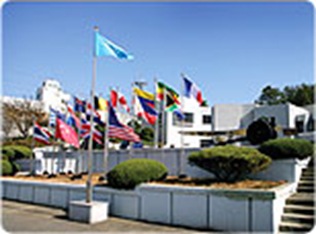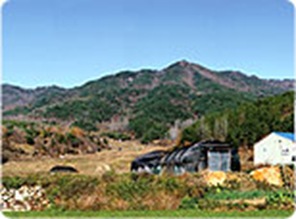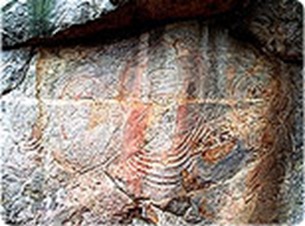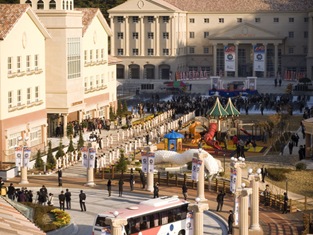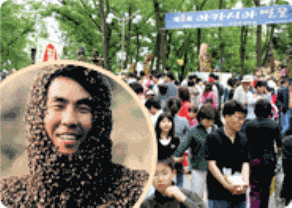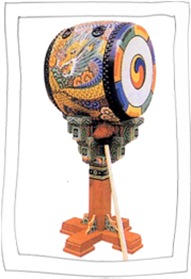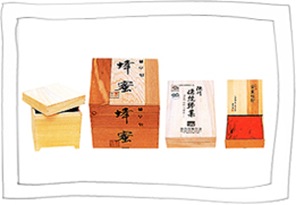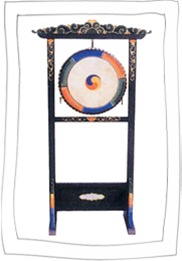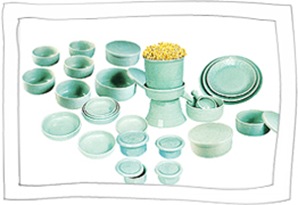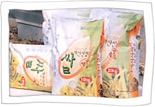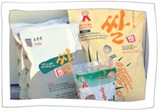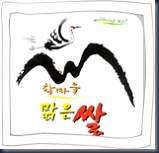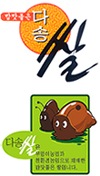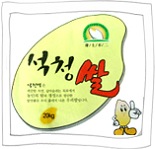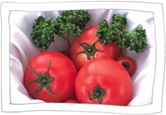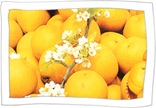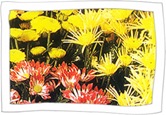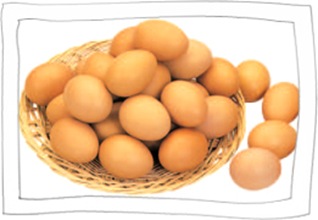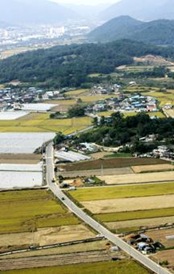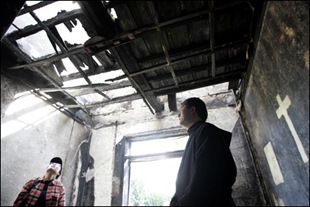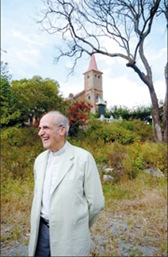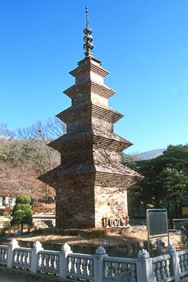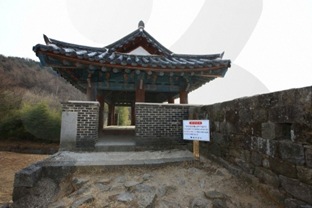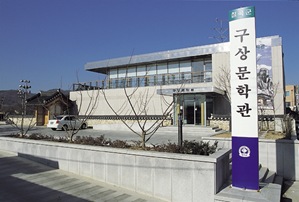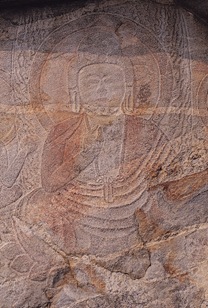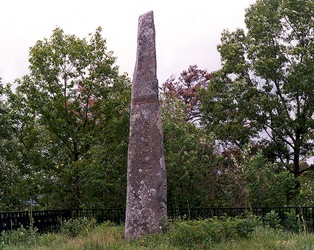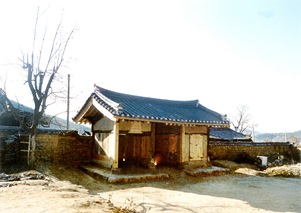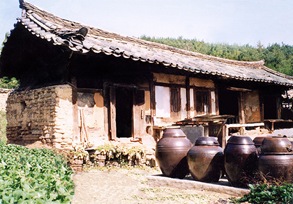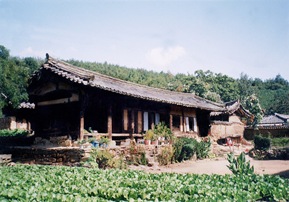The Nakdong River has played an important role throughout Korean History. The river basin has been a favored dwelling place for as long as people have inhabited the Korean Peninsular. Through the Silla, Goryeo and Joseon periods the river continued to serve as a major transportation corridor in the Gyueongsang region.
Waegwan’s name literally means “Japanese dwelling” and may indicate that the town was a common stopping point for Japanese salt traders during the Joseon Dynasty.
In the summer of 1939 Korean and Japanese students from the Daegu Normal School were sent to Waegwan to do forced labor on the Gyeongbu Line railroad tracks. A demonstration, known as the Waegwan incident took place on July 26 in which Korean students protested against preferential treatment being given to Japanese students. In consequence seven of the students were expelled.
During the Korean War it gained prominence as a barrier to movement. The bridge over the Nakdong River at Waegwan was blown up on August 3 1950 to prevent North Korean forces from advancing to Daegu. A large number of Korean refugees were killed in the explosion. The Americans believed that the refugees were North Korean soldiers in disguise. Although some of the North Korean forces did cross the Nakdong River in places, for the most part the river still marks their furthest advance.
Monuments to the UN and South Korean forces now stand on the low mountain overlooking the northeastern section of the city, which is locally known as “Apsan” or Hill 303.
In the 1990s the halves of the bridge were reconnected to serve as a pedestrian crossing between the two halves of Waegwan.
Waegwan War Memorial in Jungji-ri, Seokjeok-eup, was constructed in 1978 to commemorate the victory of the Nakdong river battle together with the U.N. forces in the Korean War. It exhibits clothing and firearms used at the time.
The Dabu-dong War Memorial in Dabu-ri, Gasan-myeon, was built to commemorate the victory of the "Dabudong Battle' which provided an opportunity to march into North Korea during the Korean war. In the building that reassembles a tank, there are exhibited all kinds of firearms and seizures during the war.
The Mt. Yuhak Area in Seonggok-ri, Seokjeok-eup, stands 839m high and is known as the mountain of cranes. It used to be the battle field of Dabudong during the Korean war. Today the crane rocks are popular among mountaineers as a rock-climbing training site.
On the cliff of Mt. Dogosan are the engravings of 4 images of Buddha in red and blue known as the Noseok-dong Buddhist Image. They are presumed to have been done in the early period of unified Silla.
Did you know that there is an English village in a protected mountain setting in Yeonhwa-ri, Jicheon-myeon, Chilgok-gun, some thirty minutes away from Daegu.
In 2006 The University of Colorado at Colorado Springs, Colorado (UCCS) and Yeungjin College (YJ), Daegu, South Korea, a prominent national university in South Korea, joined forces to construct a world-class English language learning campus. The English Village offers a full immersion curriculum for children to adults, complete with various miniature versions of everything from an airport to a bank to a police station where students can interact and utilize English in real-world situations and scenarios - to train students of all ages in the usage of the English language in an experiential learning environment so to speak.
The Acacia Honey Bee Festival is held every May in Chilgok. The area around Sindongjae(Hill), Chilgok-gun is the largest habitat of acacia.
The acacia trees growing in this region, around the Sindong Pass are 30~40 years old and are distributed throughout the 1,500ha of land taking about 5% of the total forest in the region. Currently, there are about 470 beekeeping households who produce 150tons of honey a year with a profit of 18 million won
The Acacia Bee Honey Festival is an ecological and economical festival and is recognized as a true regional cultural festival which the villagers and urban dwellers in the vicinity can enjoy. It is the most natural theme festival where you can experience the ecology of the Sindong Pass, - the flowers, the trees, the wind and the acacia bee honey.
There are contests and events, such as the bee beard event, Bee Bee Karaoke, sweet scent music festival, film festival, tasting of food made with honey, acacia science exhibition, bee-sting acupuncture and photography contest.
The main programs of the Open Chilgok Long-term Learning Festival include the following programs held at different venues in Chilgok with the aim of establishing a sound local community through education.
- Cultural Performance with local citizens: Madangnorii, Family Music Festival
- Exhibition Center arranged by a life-long learning organization: ceramics, natural dying, crafts
- Learning Team Performance Hall: Samulnori, Sports Dance, Belly Dance
- Life-long learning experience booth: Experiencing tradition, Art Healing, Experience with beads, Hand-Acupuncture
- For local women groups: Participation of Woori Agriculture Products Promotion Center, charity bazaar
Every October there is a Children’s Festival where the children and students of middle and high schools in Chilgok can show off their talents by participating and in the sharing of new experiences in different surroundings. They believe that “Children are the future of Chilgok”.
Not to be outdone is the Silveriness Song Festival, also in October, where the senior citizens, aged 60 and above, from Chilgok, can perform on stage and show off their talents.
The Gasan Hak Village Festival is a gathering fair for the urban and rural farming industry. This opens at the eco-friendly Hak village in Gasan-myeon, Chilkgok-gun.
A variety of events are prepared every year, some of which include sporting events, a Hapkido performance (an art of self-defense), tug-of-war, rural experiencing events (apple picking, catching grasshoppers, making scarecrow s) and singing competitions.
The Gasan Apple Flower Festival opens on October 7th every year and the festival offers the sampling of vegetable Bibimbap, made from natural ingredients from Gasan Hak village. The festival also provides events that family members can participate in together such as making ceramics, apple peeling and digging up herbs.
The Fortress Village Nature-Friendly Vegetable Festival is held in eco-friendly Sanseong village located in the Gasan Fortress. The event promotes the sampling of natural vegetables and provides an opportunity to visit and experience an eco-friendly cropping location.
Chilgok is well-known for its master craftsmen. If you are looking for art pieces, then Chilgok is the place to buy them.
The Drum or Janggue is made of skillful and exquisite craftsmanship. This crafts shop, Gookak Yurlim Technical Art is known for its overseas customers from the numerous orders that are coming in from countries worldwide.
Sungoh Carpentry has been appointed as a special product zone shop specializing in fishing and agrarian villages by the government. They are specialized in making esthetical and detailed wooden cases using the Paulownia tree and the western red cedar.
The Chongrok Carpentry not only makes Danchong or Buddhist images but they are specialized in repairing cultural properties. The traditional techniques and coloration of carpentry is splendid.
This is the traditional tableware made by Haksan Ceramic, that is inscribed with the10 longevity symbols including the turtle and the herb of eternal youth. They are said to be able to preserve the freshness of the food for a longer period of time.
What are the special products of Chilgok? Rice tops the list with 8 different varieties, Geumjong Rice, Green Pine Needle Rice, Dasong Rice, Hak Village Natural Rice, Gasan Fortress Rice, Seokchong Rice. Acacia Rice and Hanbaek Loess Rice
For agricultural products (Fruits) there are honey melons, apples, grapes, strawberries and Gisan pears, (vegetables) Natural Water Celery, Guemnam Cucumbers and Cherry Tomatoes.
Chilgok is famous for its flowers too, especially the Chilgok Lilies (which are exported to Japan), chrysanthemums and tulips.
Now let’s see what Chilgok has to offer amongst its livestock goods? Top of the list is honey of course.
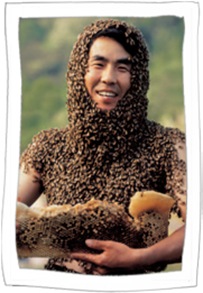 Ahn Sang-gyu Honey is aged in a beehive in a natural way to preserve its nutrients and taste. The moisture is removed naturally by movements of the bees and winds.
Ahn Sang-gyu Honey is aged in a beehive in a natural way to preserve its nutrients and taste. The moisture is removed naturally by movements of the bees and winds.
 Mt.Hwanghaksan Tobong Honey on the other hand is gathered from 300 types of flowers during March and September around the Mt.Hwanghaksan area.
Mt.Hwanghaksan Tobong Honey on the other hand is gathered from 300 types of flowers during March and September around the Mt.Hwanghaksan area.
Solran are eggs produced from the chickens that are fed with pine needle feeds. It has rich colored egg yolk with high content of calcium, iron and vitamins as compared to regular eggs.
To end today’s post I’m going to introduce you to a man, a great artist, a son of the soil. Jaewon Jung was born in 1956, in a small village, called Songjeong, (which means resting place among pine trees) in Chilgok County. He’s a highly qualified person having studied Korean language education at Kyungpook National University and earned a master's degree in Korean literature at KNU, majoring in contemporary Korean poems. He worked as a planner in the publishing department at KNU, taught the Korean language at Sinmyeong High School in Daegu, served as CEO of the Korea Educational Institute in Daegu and currently is the President of Naratmal Publishing Company and is one of the Sottae artists. His Korean Smile (Archetypical Doodles) was published in 1997 by the Naratmal Publishing Company.
Yes, he saw water lilies and lotus flowers in the lakes, while he was growing up and read about them in lots of poems and essays, but he did not truly learn to appreciate their true beauty until he planted and grew 'Tina", a tropical water lily, in a stoneware pot in 2004. Ever since then he has been growing lotuses and water lilies. In 2005, he happened to come across the website of Victoria-Adventure and was fascinated by the beauty of the various water lilies in it.
Hoping that many more Koreans will grow lotuses and water lilies and enjoy the beauty of them, he planted about 100 varieties in vessels in his roof garden in 2006. He has been distributing them to others and running a lotus-lovers society on the web. All this while he has drawn pictures of lotuses and water lilies. He has high aspirations as he thinks that his collection will be larger in size and number than those of Claude Monet in the future.
Being the creative person he is, he likes to create something new, he is always searching for new species of water lilies. He is not selfish, he wants to beautify his surroundings even more so that he can share all that with others. He owns a mountain of 500,000 square meters (124 acres) near his residence in Daegu, where he plans to turn it into an art park with an art gallery and an arboretum, so that people can appreciate art crafts and pictures in the beautiful space, all under one roof. In the art park he will make reservoirs by draining water from the creeks, and plant flowers and trees systematically. Here is a man of dreams and visions. I wish him all the best and may his efforts be crowned with success. Who knows, perhaps one day I might be lucky enough to step into his art park because I too love to plant lotuses and water lilies.
And with this we bid farewell to our trip to Chilgok-gun, Gyeongsangbuk-do.
Special thanks and appreciation to the following:
Photos and articles © courtesy
http://www.panoramio.com/photo/7471110
http://wapedia.mobi/en/University_of_Colorado_at_Colorado_Springs



